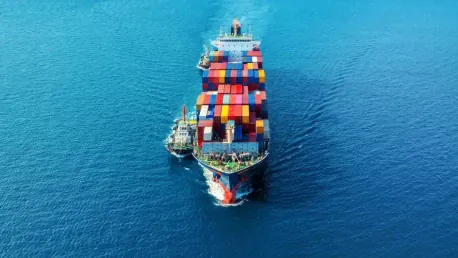A groundbreaking report from the American Bureau of Shipping (ABS) delves into the feasibility and transformational potential of employing nuclear propulsion, specifically small modular reactors (SMRs), in LNG carriers. Partnering with Herbert Engineering Corporation (HEC), the study evaluates the implications of integrating a high-temperature, gas-cooled reactor (HTGR) for the design, operation, and emissions of a 145,000 cubic meter LNG carrier. This work suggests a future where the shipping industry could achieve zero-emission operations and faster transit speeds through advanced nuclear technology.
ABS’s report brings attention to the conversion of HTGR technology for marine use, an area fraught with both challenges and opportunities. The primary focus lies on adapting this land-based technology to the maritime environment. Key areas investigated include the specific structural designs needed to accommodate the new reactors and the operational shifts required to maintain them. Notably, these reactors must undergo replacement every six years, necessitating new regulations and design rules to ensure their safe and efficient use at sea. The potential payoff, however, is significant: faster ships with zero emissions and operational efficiencies previously unattainable.
Transformative Potential of HTGR in Maritime Applications
Conversion and Design Considerations
The study conducted by ABS and HEC highlights the conversion of HTGR technology for use in maritime environments, emphasizing both the challenges and opportunities inherent in this endeavor. One of the most significant hurdles is the development of specific structural designs to house the reactors. Unlike traditional fuel tanks, these reactors would be located at the rear of the vessel, with batteries positioned forward of the reactor space. This setup necessitates a reinforced hull, a design requirement that is particularly crucial for larger LNG carriers. The reinforcement ensures the vessel’s structural integrity while housing the reactors and tackling various dynamic maritime conditions.
Additionally, the need for specialized rules and standards to govern the installation and operation of these reactors cannot be overstated. The reactors would require replacement every six years, imposing a strict timeline on vessel operations and maintenance. Developing and implementing these new design rules pose a substantial challenge but are critical for the success of such advanced technology. The potential benefits, however, are compelling: an LNG carrier powered by HTGR could sail with zero emissions and achieve faster transit speeds, thus revolutionizing the industry.
Operational Efficiency and Environmental Impact
ABS’s research underlines the potential for substantial operational efficiencies and environmental benefits. Nuclear-propelled LNG carriers equipped with HTGR could drastically reduce or even eliminate the need for refueling. This advancement mirrors findings from earlier studies on different vessel types, including a 14,000 twenty-foot equivalent unit (TEU) container vessel and a 157,000 deadweight tonnage (DWT) Suezmax tanker. Both studies concluded that advanced nuclear reactors could offer zero carbon emissions during their operational lifetimes. The 14,000 TEU container vessel, for instance, would not require refueling for its entire 25-year lifespan. Similarly, the Suezmax tanker would benefit from operational speed with minimal refueling, though installing microreactors would reduce cargo capacity.
Reducing carbon emissions is an urgent priority for the maritime industry, given global climate obligations and evolving environmental regulations. Nuclear propulsion presents a compelling solution to meet these requirements while maintaining efficiency. By emphasizing the potential for both reduced emissions and operational efficiency, ABS’s report envisions a transformative shift for the industry. The HTGR’s ability to deliver zero-emission operations without compromising transit speeds offers a viable path forward, capturing the interest of stakeholders aiming for sustainable shipping solutions.
Industry-Wide Implications and Future Developments
Expanding Beyond LNG Carriers
The overarching trends from ABS’s research suggest a growing interest in nuclear propulsion that extends beyond LNG carriers. This interest encompasses various types of vessels and applications, driven by the broader potential benefits of advanced nuclear technology. ABS and HEC’s earlier studies on different vessel types underscore the versatility and applicability of nuclear propulsion across the maritime sector. This includes container vessels and oil tankers, which could also benefit from the long-term operational efficiencies and zero-emission credentials offered by advanced reactors. The trend points towards a broader adoption of nuclear technology within the industry, setting the stage for significant innovations beyond LNG carriers.
Collaboration with other institutions further emphasizes ABS’s commitment to nuclear propulsion. Their work with the Korea Research Institute of Ships and Ocean Engineering (KRISO) on commercial SMR-powered ships and floating SMR power platforms exemplifies the collaborative efforts aimed at advancing this technology. Moreover, ABS has introduced the maritime industry’s first comprehensive rules for floating nuclear power plants, paving the way for safe and efficient implementation. These initiatives reflect a concerted effort to explore the full spectrum of nuclear propulsion applications in maritime contexts, aiming to drive widespread industry adoption.
Strategic Partnerships and Rule Development
A groundbreaking report by the American Bureau of Shipping (ABS) explores the feasibility and revolutionary potential of using nuclear propulsion, specifically small modular reactors (SMRs), in LNG carriers. Collaborating with Herbert Engineering Corporation (HEC), the study examines how a high-temperature, gas-cooled reactor (HTGR) could impact the design, operation, and emissions of a 145,000 cubic meter LNG carrier. This suggests a future where the shipping industry could achieve zero-emission operations and faster transit times through advanced nuclear technology.
The ABS report emphasizes the complex task of converting HTGR technology for marine use. Adapting this land-based technology to the maritime environment presents both challenges and opportunities. The study focuses on the structural changes needed to house the reactors and the operational adjustments necessary to maintain them. These reactors require replacement every six years, prompting the need for new regulations and design standards to ensure their safety and efficiency at sea. The potential benefits are enormous: faster ships, zero emissions, and operational efficiencies that were previously out of reach.









